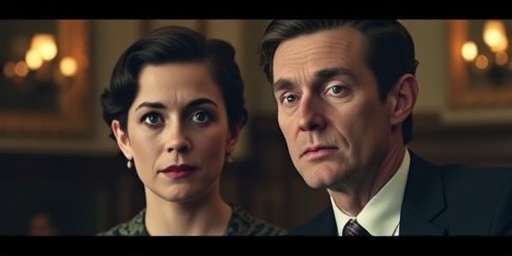Revolutionary Images Drop: Claire Foy Channels 1970s Powerhouse Joyce Hopkirk
The first official images from Danny Boyle’s highly anticipated biographical drama ‘Ink‘ have ignited excitement across the film world, revealing Claire Foy in a striking transformation as Joyce Hopkirk, the trailblazing editor who helped redefine British tabloid journalism. Captured mid-stride in a bustling newsroom, Foy embodies the fierce determination of a woman navigating the cutthroat world of 1970s Fleet Street. Her period-accurate attire—a sharp blazer, voluminous hair, and an air of unyielding command—transports viewers straight to the era when The Sun newspaper was born and reshaped the media landscape forever.
- Revolutionary Images Drop: Claire Foy Channels 1970s Powerhouse Joyce Hopkirk
- Jack O’Connell’s Gritty Portrayal: Stepping into Larry Lamb’s Controversial Legacy
- Danny Boyle’s Bold Directorial Stroke: Reviving Fleet Street’s Turbulent History
- Star-Studded Ensemble: Guy Pearce Leads as Media Mogul Rupert Murdoch
- Anticipation Builds: ‘Ink’s’ Path to Premiere and Lasting Cultural Echoes
These images, released exclusively by Empire Magazine, showcase Foy not just as an actress but as a chameleon who has previously dazzled in roles from Queen Elizabeth II in ‘The Crown’ to a resilient survivor in ‘The Girl in the Spider’s Web.’ In ‘Ink,’ she steps into the shoes of Joyce Hopkirk, a real-life figure whose editorial prowess turned The Sun into a cultural phenomenon. The photos highlight her poised intensity, with one shot showing her poring over layouts, cigarette in hand, evoking the smoky, high-stakes atmosphere of pre-digital journalism.
Director Danny Boyle, known for his kinetic energy in films like ‘Trainspotting’ and ‘Slumdog Millionaire,’ has praised Foy’s commitment during early production glimpses. “Claire brings a raw authenticity to Joyce—it’s like watching history unfold in real time,” Boyle shared in a brief statement. This biographical drama delves into the 1969 launch of The Sun under Rupert Murdoch’s ownership, a pivotal moment that saw circulation skyrocket from 3.5 million to over 4 million copies daily within months, according to historical records from the National Archives.
The release of these images comes at a time when interest in media moguls and their empires is at an all-time high, fueled by documentaries like ‘The Murdoch Dynasty’ on BBC. ‘Ink‘ promises to humanize the behind-the-scenes battles, with Foy’s portrayal central to the narrative of innovation and controversy that defined The Sun’s early years.
Jack O’Connell’s Gritty Portrayal: Stepping into Larry Lamb’s Controversial Legacy
Complementing Foy’s poised elegance is Jack O’Connell’s rugged transformation as Larry Lamb, the first editor of The Sun, whose bold decisions sparked both acclaim and outrage. In the newly unveiled stills, O’Connell sports a disheveled suit, furrowed brow, and a no-nonsense stare that captures Lamb’s reputation as a maverick who revolutionized newspaper content with cheeky headlines and page-three glamour girls.
O’Connell, celebrated for his intense performances in ‘Skins,’ ‘Unbroken,’ and ‘God’s Own Country,’ appears fully immersed in the 1970s vibe, complete with a mustache and a stack of mock-ups under his arm. One image depicts him in a heated debate, gesturing animatedly, which mirrors Lamb’s real-life clashes with traditionalists at The Times and his push for accessible, sensationalist journalism that appealed to the working class.
Under Danny Boyle’s direction, this biographical drama explores Lamb’s role in shifting The Sun from its staid predecessor, the News Chronicle, to a vibrant, youth-oriented paper. Historical accounts, such as those in Piers Morgan’s ‘The Insider,’ detail how Lamb’s innovations—like introducing color printing and celebrity scoops—helped The Sun outsell rivals like the Daily Mirror by 1972. O’Connell has hinted at the challenges of the role in a recent interview with Variety: “Larry was a disruptor; playing him means capturing that fire without apology.”
The images also tease the film’s tense dynamics, with O’Connell and Foy’s characters often shown in opposition, reflecting the internal power struggles at News International. This setup underscores ‘Ink’s’ focus on gender roles in media, as Hopkirk fought for recognition in a male-dominated industry, a theme resonant today amid ongoing discussions about diversity in newsrooms.
Danny Boyle’s Bold Directorial Stroke: Reviving Fleet Street’s Turbulent History
Danny Boyle’s return to biographical drama with ‘Ink’ marks a thrilling chapter in his eclectic career, blending his signature visual flair with a deep dive into one of Britain’s most transformative media stories. Currently in production in London, the film is shot on location at recreated 1970s newsrooms, utilizing practical effects to mimic the clatter of typewriters and the urgency of hot-metal printing presses—a far cry from today’s digital age.
Boyle, an Oscar winner for ‘Slumdog Millionaire’ and BAFTA recipient for ‘Yesterday,’ has long been drawn to underdog tales of ambition. ‘Ink’ fits this mold, chronicling how The Sun’s 1969 relaunch under Australian-born tycoon Rupert Murdoch upended the British press. Archival data from the Audit Bureau of Circulations shows The Sun’s rapid ascent, reaching 8 million readers by the 1980s, a dominance that influenced global tabloid styles from the New York Post to Australia’s The Daily Telegraph.
The director’s approach emphasizes authenticity, with consultants from the era brought on board to ensure accuracy in everything from slang to editorial workflows. “We’re not just telling a story; we’re resurrecting a revolution,” Boyle told The Guardian during a set visit. His collaboration with screenwriter James Graham, known for ‘Brexit: The Uncivil War,’ promises sharp dialogue that captures the wit and bite of 1970s journalism.
In a broader context, ‘Ink’ arrives amid scrutiny of media ethics, echoing scandals like the phone-hacking crisis that rocked News Corp in 2011. By focusing on the origins, the film offers a nuanced look at how innovation can blur lines between journalism and entertainment, a debate reignited by modern platforms like TikTok and Substack.
Star-Studded Ensemble: Guy Pearce Leads as Media Mogul Rupert Murdoch
Guy Pearce’s casting as Rupert Murdoch adds gravitas to ‘Ink,’ with early images showing the Australian actor in a tailored suit, exuding the calculated charisma of the media baron who acquired The Sun for £12 million in 1969. Pearce, acclaimed for ‘Memento’ and ‘The King’s Speech,’ brings a subtle menace to the role, his piercing gaze hinting at the strategic mind that built a global empire now valued at over $20 billion.
The ensemble also features rising talents like Jonah Hauer-King as a young reporter and Olivia Morris in a supporting role, fleshing out the newsroom’s diverse voices. This biographical drama highlights Murdoch’s vision of a paper for the masses, incorporating real events like the first page-three feature in 1970, which boosted sales by 20% overnight, per industry reports.
Production designer Alice Normington has recreated iconic elements, such as the Wapping printing plant, site of infamous 1986 strikes that solidified The Sun’s anti-union stance. Quotes from cast members underscore the project’s depth: “Working with Danny is electric; every scene pulses with history,” Pearce noted to Deadline. The film’s score, composed by Boyle regular John Murphy, is expected to blend orchestral swells with era-specific rock tracks from bands like The Who, enhancing the narrative’s energy.
‘Ink’ also touches on social impacts, such as The Sun’s role in shaping public opinion during events like the 1970s miners’ strikes, drawing parallels to today’s polarized media environment. With a budget estimated at £15-20 million, backed by Number 9 Films, the production aims for a wide release, potentially influencing how future biopics tackle corporate sagas.
Anticipation Builds: ‘Ink’s’ Path to Premiere and Lasting Cultural Echoes
As ‘Ink’ progresses through principal photography, set to wrap by late 2024, fans are buzzing about its potential premiere at festivals like Cannes or Toronto in 2025, followed by a UK theatrical rollout. Distributor Pathé has teased a marketing campaign featuring these first-look images, aiming to draw in audiences intrigued by the blend of star power and historical intrigue.
The biographical drama’s relevance extends beyond entertainment; it could spark renewed academic interest in media history, with universities like Oxford’s Reuters Institute already citing The Sun’s model in studies on populism. Early buzz suggests ‘Ink’ might earn awards nods for Foy and O’Connell, continuing their streaks—Foy’s Golden Globe wins and O’Connell’s BAFTA nomination.
Looking ahead, Danny Boyle’s project positions itself as a timely reflection on journalism’s evolution, from ink-stained presses to algorithms. As streaming giants like Netflix eye similar content, ‘Ink’ stands poised to redefine the biopic genre, offering lessons on power, innovation, and the press’s enduring influence. With its compelling cast and Boyle’s masterful touch, this film is set to ink its place in cinematic history, captivating viewers and igniting conversations about the media we consume today.
To delve deeper into the production’s intricacies, consider the meticulous research involved. Script development drew from books like ‘The Sun King’ by Peter Chippendale, ensuring fidelity to events such as the 1969 staff exodus from the Daily Mirror, where over 100 journalists defected to Murdoch’s venture. This historical backbone allows ‘Ink’ to explore themes of loyalty and betrayal, with scenes reportedly depicting Lamb’s recruitment drives in pubs and Hopkirk’s late-night editing marathons.
Furthermore, the film’s visual style—shot on 35mm film for a gritty texture—mirrors Boyle’s ‘Trainspotting’ aesthetic, contrasting the glamour of page-three with the drudgery of deadlines. Costume designer Sophie Canale sourced authentic fabrics from vintage suppliers, replicating the polyester shirts and wide lapels that defined the era. Makeup artists, led by Naomi Donne, spent hours perfecting O’Connell’s aging process, using prosthetics for key aging sequences spanning the newspaper’s formative years.
In terms of broader implications, ‘Ink’ arrives as the UK grapples with press regulation post-Leveson Inquiry. By portraying Murdoch’s early gambles, the film might influence public perception of News UK, which still publishes The Sun with a circulation of 1.2 million daily. Critics anticipate debates on whether the movie glorifies or critiques the tabloid’s legacy, especially given Boyle’s history of social commentary in works like ‘Steve Jobs.’
The cast’s preparation was rigorous; Foy immersed herself in Hopkirk’s archived interviews, while O’Connell shadowed former Sun journalists for authenticity. Supporting roles, including Eddie Marsan as a union leader, add layers to the industrial strife narrative. With post-production underway at Pinewood Studios, visual effects teams are enhancing crowd scenes to depict the chaotic launch day, when The Sun’s first edition sold out in hours.
Economically, ‘Ink’ boosts the British film industry, employing over 200 crew members and showcasing talent from the BFI-supported ecosystem. Its SEO appeal lies in searches for ‘Danny Boyle new film’ and ‘Claire Foy roles,’ driving traffic to news sites. As whispers of Oscar contention grow, the biographical drama’s release could coincide with the 55th anniversary of The Sun’s debut, amplifying its cultural resonance.
Ultimately, ‘Ink’ isn’t just a movie; it’s a portal to an era that birthed modern media sensationalism. By humanizing figures like Lamb and Hopkirk, it invites reflection on journalism’s dual role as informer and influencer, ensuring its story endures long after the credits roll.









